Checking Out the current Technological Improvements in Optometry and What They Mean for Optometrists
From the accuracy of Optical Coherence Tomography to the nuanced understandings supplied by AI-driven diagnostic tools, these developments are setting new requirements in patient evaluation and treatment. As these innovations penetrate the practice, eye doctors are faced with the difficulty of welcoming these tools to improve individual outcomes.
Developments in Diagnostic Tools
Advancing the area of optometry, advancements in analysis tools have actually transformed the way eye treatment specialists examine and detect visual impairments and eye problems. The previous years has actually seen substantial technological innovations, enabling more exact and detailed assessments. Optical Comprehensibility Tomography (OCT), for example, provides high-resolution cross-sectional photos of the retina, permitting the very early discovery of conditions such as glaucoma and age-related macular deterioration. This non-invasive imaging strategy has actually ended up being indispensable in contemporary optometric practice.
Another key advancement is the intro of advanced corneal topography systems, which map the surface area curvature of the cornea with accuracy. These tools are specifically advantageous for fitting call lenses and identifying corneal conditions. Moreover, digital retinal imaging has actually changed standard ophthalmoscopy, using detailed, panoramic views of the retina that facilitate complete aesthetic evaluations.
The advancement of wavefront aberrometry has actually likewise been vital, enabling the evaluation of refractive mistakes with unrivaled precision (Eye Doctor Optometrist). This technology aids in tailoring corrective lenses and enhancing surgical outcomes for refractive surgical procedures. Collectively, these diagnostic improvements empower optometrists to supply exceptional individual care, making certain very early intervention and tailored therapy approaches, eventually boosting visual health and wellness outcomes
AI in Individual Management
Building on the foundation of cutting-edge diagnostic devices, the incorporation of man-made intelligence (AI) in patient monitoring stands for a transformative leap for optometry. AI systems are significantly utilized to improve effectiveness, accuracy, and personalization in individual care.
In addition, AI-driven systems assist in streamlined client interactions and administrative procedures. Automated scheduling, virtual consultations, and customized follow-up plans not only enhance person contentment but also maximize time monitoring for practitioners. These systems can triage patients based upon the urgency of their conditions, making certain that those in critical need receive timely interest.
In addition, AI improves decision-making by providing eye doctors with evidence-based referrals and treatment paths. By incorporating data from digital wellness records, AI devices use insights that inform medical decisions, reducing the risk of mistakes and improving person end results. As AI remains to progress, its function in client management will likely expand, improving the landscape of optometric treatment.
Advances in Retinal Imaging
In the realm of optometry, retinal imaging has observed remarkable technological developments that are boosting analysis abilities and individual care. Advancements such as Optical Comprehensibility Tomography (OCT) and fundus digital photography have actually transformed exactly how optometrists imagine and evaluate the retina. OCT, in certain, supplies high-resolution, cross-sectional pictures of the retina, enabling the comprehensive exam of its layers. This capability is vital for very early discovery and management of conditions like glaucoma, diabetic person retinopathy, and age-related macular degeneration.
Improved imaging techniques like OCT angiography are more refining diagnostic accuracy. Eye Doctor Optometrist. Such innovations facilitate the recognition of min retinal modifications that might signify illness development.
Furthermore, improvements in synthetic intelligence are augmenting retinal imaging by making it possible for computerized analysis of large datasets. These systems aid eye doctors in recognizing patterns a sign of pathology, therefore improving analysis precision and performance. Jointly, these developments are changing retinal imaging right into a foundation of contemporary eye care, enhancing end results and increasing healing possibilities.
Teleoptometry's Expanding Duty
Teleoptometry is progressively coming to be an important part of eye treatment, driven by developments in digital communication and diagnostic devices. This is specifically beneficial in country and underserved areas where accessibility to specialized eye care is commonly limited.
The assimilation of expert system (AI) more boosts teleoptometry, enabling the evaluation of visual information and assisting in best site the discovery of ocular problems such as glaucoma and diabetic retinopathy. AI-powered algorithms can quickly translate complicated imaging data, offering optometrists with important understandings that reinforce professional decision-making.
Furthermore, teleoptometry sustains connection of care through smooth combination with digital health and wellness documents (EHRs), enabling optometrists to maintain extensive patient backgrounds. This ensures that patients obtain personalized and consistent treatment even when consulting with various experts.
Regardless of these benefits, obstacles stay, consisting of guaranteeing information safety and taking care of client assumptions. Nevertheless, teleoptometry stands for a substantial stride towards even more obtainable, efficient, and patient-centered eye care. As modern technology progresses, its role is positioned to expand additionally.

Future Patterns in Eye Care
A myriad of cutting-edge fads is readied to improve the future of eye treatment, driven by technological advancements and the progressing needs of individuals. One considerable pattern is the assimilation of artificial intelligence (AI) in diagnostics, which assures to boost the precision and efficiency of eye assessments. AI formulas can evaluate large quantities of data from retinal images, possibly detecting conditions like diabetic retinopathy and glaucoma earlier than traditional methods.
In addition, customized medicine is gaining grip in optometry, with genetic screening educating personalized treatment strategies. This method intends to optimize individual outcomes by customizing interventions to private hereditary profiles. Wearable innovation, such as directory smart call lenses, is additionally imminent, supplying real-time surveillance of intraocular stress or sugar degrees, therefore offering continual understandings right into systemic and ocular wellness.
The fostering of augmented reality (AR) and virtual fact (VR) in training and patient education is one more emerging fad. These innovations use immersive experiences that can improve understanding and abilities both for eye doctors and patients. As these trends advance, eye doctors have to remain abreast of technological improvements to offer advanced treatment, making certain better person results and fulfillment in the vibrant landscape of eye treatment.
Final Thought

Jointly, these diagnostic developments empower eye doctors to deliver premium individual treatment, making sure early intervention and tailored treatment approaches, ultimately enhancing visual health outcomes.

As these technologies proceed to advance, eye doctors need to adapt and incorporate them into technique, ultimately enhancing operations performance and boosting the requirement of eye treatment provided to individuals.